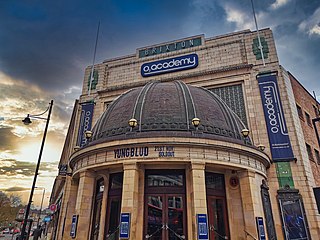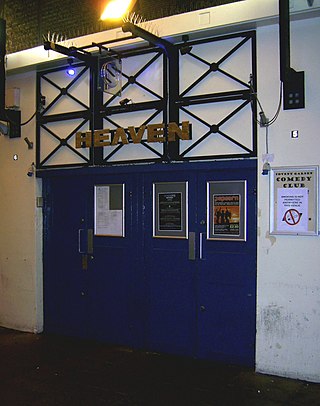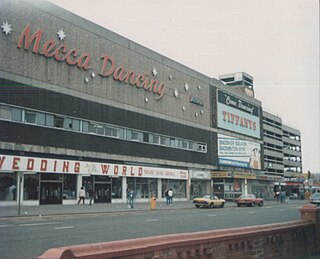
A rave is a dance party at a warehouse, club, or other public or private venue, typically featuring performances by DJs playing electronic dance music. The style is most associated with the early 1990s dance music scene when DJs played at illegal events in musical styles dominated by electronic dance music from a wide range of sub-genres, including drum and bass, dubstep, trap, break, happy hardcore, trance, techno, hardcore, house, and alternative dance. Occasionally live musicians have been known to perform at raves, in addition to other types of performance artists such as go-go dancers and fire dancers. The music is amplified with a large, powerful sound reinforcement system, typically with large subwoofers to produce a deep bass sound. The music is often accompanied by laser light shows, projected coloured images, visual effects and fog machines.

Julius O'Riordan, better known by his stage name Judge Jules, is a British dance music DJ, record producer and entertainment lawyer. He is known for his DJ activities, music production and long-running radio show which achieved global success. He was voted best DJ in the world by DJ Mag in 1995.
Goa trance is an electronic dance music style that originated in the early 1990s in the Indian state of Goa. Goa trance often has drone-like basslines, similar to the techno minimalism of 21st century psychedelic trance (psytrance). Psychedelic trance developed from Goa trance. The typically long songs built on progressive beat changes are said to put the listener in a “trance”.

Northern soul is a music and dance movement that emerged in Northern England and the Midlands in the early 1970s. It developed from the British mod scene, based on a particular style of Black American soul music with a heavy beat and fast tempo.

Brixton Academy (originally known as the Astoria Variety Cinema, previously known as Carling Academy Brixton, currently named O2 Academy Brixton as part of a sponsorship deal with the O2 brand) is a mid-sized concert venue located in South West London, in the Lambeth district of Brixton.
The Roxy was a fashionable nightclub located at 41–43 Neal Street in London's Covent Garden, known for hosting the flowering British punk music scene in its infancy.

Soul II Soul are a British musical collective formed in London in 1988. They are best known for their two major hits; 1989's UK number five and US number eleven "Keep On Movin'", and its follow-up, the UK number one and US number four "Back to Life". They have won two Grammy Awards, and have been nominated for five Brit Awards—twice for Best British Group.

Avi Shmailov, known by his stage name Astrix, is an Israeli trance music DJ and producer. His specialty lies in the subgenre of progressive psychedelic trance. In 2006, Astrix achieved the 41st position in DJMag's "Top 100 DJs" annual ranking, alongside several other Israeli musicians, with Infected Mushroom ranking the highest at #9. The following year, in 2007, Astrix climbed to the 18th spot on the list, marking a significant representation of the Israeli electronic music scene in the global rankings.,
UK hard house or simply hard house is a style of electronic dance music that emerged in the early 1990s and is synonymous with its association to the Trade club and the associated DJs there that created the style. It often features a speedy tempo, offbeat bass stabs, hoovers and horns. It usually contains a break in the middle of the track where no drums are present. UK hard house often uses a long and sharp string note to create suspense. Most of the time, the drops are introduced by a drum roll.

The End was a nightclub in the West End of London, England. Started in December 1995 by DJs Layo Paskin and Mr C, it was also responsible for the label End Recordings.
The Zap was a beach-front nightclub and performance arts venue, in Brighton, England that became known in the late 1980s and early 1990s particularly for its acid house nights. It has been described as an "influential ... club which pulled together many of the underground strands of visual art, fashion, music, design, comedy, cabaret and theatre which were circling at the time".
Return to the Source (RTTS) was a London-based Goa trance club and offshoot record label run by partners Chris Decker, Mark Allen, Janice Duncan and Phil Ross. Along with the recurring Escape from Samsara party, which also had a monthly Friday night slot at The Fridge in the mid-1990s, it was an early mainstay of trance in its underground days and through its breakout in the late 1990s. According to Allmusic, its "compilation series of the best trance music on the scene...brought Goa trance to the mainstream hordes".

Heaven is a gay superclub in Charing Cross, London, England. It has played a central role and had a major influence in the development of London's LGBT scene for over 40 years and is home to long-running gay night G-A-Y. The club is known for Paul Oakenfold's acid house events in the 1980s, the underground nightclub festival Megatripolis, and for being the birthplace of ambient house.

The Blackpool Mecca was a large entertainment venue on Central Drive in the seaside town of Blackpool, Lancashire, in North West England, first opened in 1965. In the 1970s, it was particularly known for The Highland Room, which was a major Northern Soul music venue. From 1977 onwards it was also host to the Commonwealth Sporting Club. The building was closed down in 1980s and was finally demolished in January 2009 to make way for new campus buildings of Blackpool and The Fylde College. However, following an issue with funding B&FC withdrew and as of 2013 the site is planned for residential development.

Tribal Gathering is the original British electronic dance music festival that between 1993 and 2004 catered for different types of dance music cultures such as techno, house and drum & bass. After 18 years, Tribal Gathering returns in 2023 for a two-day event to celebrate its 30th anniversary.
Megatripolis was an underground London club-night created by Encyclopaedia Psychedelica/Evolution editor and founder of the Zippie movement Fraser Clark, partner Sionaidh Craigen, as well as a great many others. The club combined New Age ideology with Rave culture to create a vibrant, festival-like atmosphere presenting a wide variety of cross-cultural ideas and experiences. Club nights ran regularly on Thursdays from 1992 until 1995, being the focus of much of the Zippie movement. The club and its related activities such as the Sunday club for mothers and children and those interested in a more relaxed sharing of support, also helped to popularise ideas such as cyberculture and the Internet between those years.

Ariel Belloso is an Argentine, UK-based DJ and record producer. He began his career playing new wave and disco music at clubs in the city of Rosario during the early 1980s, later in Buenos Aires; and moved to London in 1991, after spending 8 months in Ibiza, where he was influenced by the early house and acid house sounds.

How Does It Feel to Be Loved? is a London-based nightclub which predominantly plays indie pop, Northern Soul and Motown music. On the club's website, founder Ian Watson explains: "We love pop, we love guitars that jangle, we love foot stomping melodies and huge choruses." The club's name is taken from the lyrics to The Velvet Underground song "Beginning to See the Light".
The Weekender Club and Weekender Café was a music venue in Innsbruck, Tyrol, Austria. It programmed a broad variety of musical events reaching from live concerts and club nights with DJs, through to album release parties and guest events. In May 2017 it was closed, but there are still concerts presented by weekender in Innsbruck taking place.
Nicky Holloway is an English DJ and record producer, who rose to fame in the 1980s and 1990s, and has been called "a prototype of the superstar DJ".
















